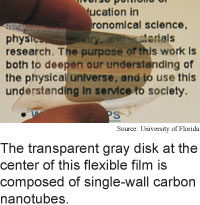
Nanotubes form transparent film
The key to making foldable computer displays
is finding electrical components that conduct electricity well and are
also transparent and flexible.
Researchers from the University of Florida at Gainesville and
the Hungarian Academy of Sciences have found a way to make flexible, transparent
films of single-walled carbon nanotubes that have a maximum amount of
contact between nanotubes within the film, which makes the film a good
electrical conductor.
Carbon nanotubes are rolled-up sheets of carbon atoms that can
be smaller than a nanometer and have useful electrical and optical properties.
A nanometer is one millionth of a millimeter, or the span of a row of
10 hydrogen atoms.
The film could eventually be used to make foldable computer displays,
infrared cameras and line-of-sight optical communication devices.
The researchers made the films by suspending nanotubes in liquid,
filtering them out using a membrane, then dissolving the membrane. The
films have consistent thicknesses that can be controlled with nanoscale
precision, according to the researchers. They have made films as large
as 10 centimeters in diameter and 50 to 150 nanometers thick.
The 50-nanometer film transmits 70 percent of visible light and
90 percent of infrared light. The researchers used the film to make an
optical field-effect transistor, which changes transparency in the presence
of an electric field.
The method could be used practically within two years, according
to the researchers. The work appeared in the August 27, 2004 issue of
Science.
Biochip spots single viruses
Cooler material boosts fuel cells
Pen stroke cuts PDA Web clutter
Wide laser makes simple tweezers
Briefs:
Biochip levitates droplets
Nanotubes form transparent film
Molecules positioned on silicon
Mechanical valve design goes nano
Angles increase optical storage
Crystal links ultraviolet photons

Research Watch blog
View from the High Ground Q&A
How It Works
RSS Feeds:
News
Ad links:
Buy an ad link
Ad links: Clear History
Buy an ad link
|
TRN
Newswire and Headline Feeds for Web sites
|
© Copyright Technology Research News, LLC 2000-2010. All rights reserved.